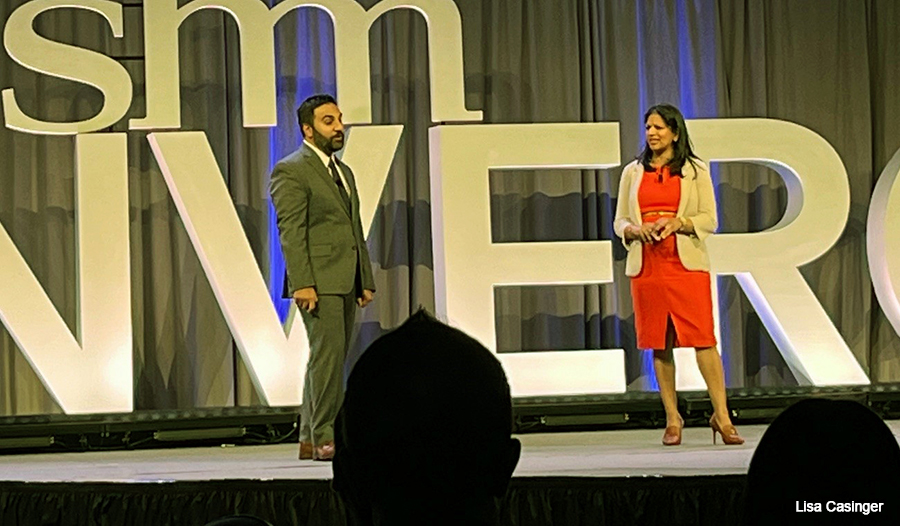
Dr. Zahir Kanjee (left) and Dr. Suchita Shah Sata educated—and entertained!—with their updates in hospital medicine.
This year’s annual Update in Hospital Medicine transported learners to the San Diego Zoo where they heard from dynamic speakers Dr. Suchita Sata and Dr. Zahir Kanjee. They took the audience on a fun-filled “rounding trip” to the zoo, discussing literature from 2023 that led to key practice updates and confirmations in pneumonia, sepsis, venous thromboembolism (VTE) prophylaxis, atrial fibrillation, heart failure, and much more!
Sepsis is a common reason for hospital admission, often triggered by conditions like pneumonia. The CAPE COD (Community-Acquired Pneumonia: Evaluation of Corticosteroids) trial gave severe community-acquired pneumonia (CAP) a new twist, finding that in 795 adults with severe CAP but without shock, early use of hydrocortisone reduced 28-day mortality by 5.6%, preventing death in one out of every 18 patients.1 Secondary endpoints also showed no difference in hospital-acquired infection and GI bleeding.
Next, the CLOVERS (Crystalloid Liberal or Vasopressors Early Resuscitation in Sepsis) trial explored the difference between restrictive and liberal intravenous fluid administration strategies in patients with sepsis-induced hypotension after initial bolus, finding there was no difference in 90-day mortality.2 Fluids are a key pillar in sepsis management along with antibiotics, which are crucial to gaining source control, however, they are not without risk.
The ACORN (Antibiotic Choice on Renal Outcomes) trial looked at two of the most commonly used empiric antipseudomonal antibiotics, piperacillin-tazobactam, and cefepime.3 More than 2,500 patients were enrolled at a single center with the primary outcome measure of acute kidney injury or death at 14 days. The study showed that piperacillin-tazobactam did not increase the risk of acute kidney injury or death when compared to cefepime. However, cefepime did show a small increase in neurotoxicity.
If your heart wasn’t pumping with excitement already, the speakers broached cardiology topics. If you are like most hospitalists, some of your most common ward calls are for new-onset atrial fibrillation with rapid response. The AFOTS (Atrial Fibrillation Occurring Transiently with Stress) trial aimed to prospectively study atrial fibrillation occurring transiently with stress in hospitalized patients.4 They found that one-third of patients who developed atrial fibrillation in the hospital, and were in normal sinus rhythm at discharge, had it reoccur. However, it didn’t answer the question of anticoagulation needs, but should be considered as a factor guiding shared decision-making with evaluation of other comorbidities.
Extremity fractures in the general population carry with them a host of potential morbidities, one of the more common being thromboembolic events. The speakers hopped on to the PREVENT CLOT (Prevention of Clots in Orthopaedic Trauma) trial, a large study randomizing patients to enoxaparin or aspirin after surgical treatment of a fracture.5 This study demonstrated the noninferiority of aspirin to enoxaparin, with similar rates of mortality and fatal thromboembolic events, but non-fatal deep vein thromboembolism (DVT) still occurred more frequently in the aspirin group. The search for perfect postoperative VTE continues, but DVT prevention is still better achieved by enoxaparin in this population.
And who can forget heart failure, one of the most common presentations hospitalists manage? A recently published article in the Journal of Hospital Medicine aimed to examine the following three trials: DOSE (Diuretic Optimization Strategies Evaluation), ROSE (Reevaluation of Systemic Early Neuromuscular Blockade), and ATHENA-HF (Aldosterone Targeted Neurohormonal Combined with Natriuresis Therapy in Heart Failure).6 We all know: diurese, diurese, diurese, but the American College of Cardiology guidelines don’t tell us how much or how fast is best. This analysis showed that an aggressive net negative fluid status at 48 hours likely best balances symptom improvement (primarily dyspnea) with avoidance of kidney injury and decreased chances of rehospitalization.
The three POISE (Perioperative Ischemic Evaluation) trials have been instrumental in guiding perioperative strategy.7 Many of us have been taught to hold angiotensin-converting enzyme inhibitors (ACEi) and angiotensin receptor blockers (ARB) on the morning of surgery and to restart on postoperative day one if context allows, while the American College of Cardiology and American Hospital Association say it’s reasonable to continue them. POISE-3 randomized patients to hypotension-avoidance (hold ACEi and ARB) versus hypertension-avoidance (continue ACEi and/or ARB). There was no significant difference in perioperative 30-day cardiovascular outcomes, so unless hypotension is a real risk, it’s likely okay to continue them. Are kidney outcomes to follow?
Lastly, what to do with asymptomatic inpatient hypertension? We see this all the time and get quite a few consults for it as well (and as an added bonus, it can make the pager light up!). This retrospective paper from the Journal of the American Medical Association-Internal Medicine evaluated older patients experiencing asymptomatic hypertension (across at least two separate readings) after being admitted for non-cardiovascular indications in the U.S. Veterans Health Administration. Patients started on a least one oral or intravenous (IV) anti-hypertensive were compared with those receiving no such treatment.8 The takeaway is clear—don’t just reflexively treat. And if you treat (remember not to anyway) don’t use IV anti-hypertensives. And in case that’s unclear: Don’t treat.
Key Takeaways
- Use hydrocortisone early in CAP with severe hypoxemia to reduce mortality.
- After bolusing sepsis-induced hypotension, perfusion is the priority: fluids or pressors.
- Enoxaparin is more effective than aspirin for DVT prevention after a traumatic fracture.
- New paroxysmal atrial fibrillation during hospitalization recurs in a third of patients within the next year.
- Aim for aggressive net-negative fluid targets for acute heart failure.
- Piperacillin-tazobactam doesn’t cause more acute kidney injury, but cefepime causes neurotoxicity.
- Perioperative blood pressure management: Not too high and not too low, just right.
- Don’t routinely treat asymptomatic hypertension in older, non-cardiovascular inpatients, especially not with IV meds.

Dr. Spaeth

Dr. Migliore
Dr. Spaeth is a first-year resident at OhioHealth Riverside Methodist Hospital in Columbus, Ohio. She serves on SHM’s Physicians-in-Training committee and is a former editorial board member of The Hospitalist magazine. Dr. Migliore is the director of consult and perioperative services, and assistant professor of medicine at Columbia University Medical Center in New York.
References
- Dequin PF, Meziani F, et al. Hydrocortisone in severe community-acquired pneumonia. N Engl J Med. 2023;388(21):1931-41.
- Shapiro NI, Douglas IS, et al. Early restrictive or liberal fluid management for sepsis-induced hypotension. N Engl J Med. 2023;388(6):499-510.
- Qian ET, Casey JD, et al. cefepime vs piperacillin-tazobactam in adults hospitalized with acute infection: the ACORN randomized clinical trial. JAMA. 2023;330(16):1557-67.
- McIntyre WF, Vadakken ME, et al. Atrial fibrillation recurrence in patients with transient new-onset atrial fibrillation detected during hospitalization for noncardiac surgery or medical illness: a matched cohort study. Ann Intern Med. 2023;176(10):1299-307.
- O’Toole RV, Stein DM, et al. Aspirin or low-molecular-weight heparin for thromboprophylaxis after a fracture. N Engl J Med. 2023;388(3):203-13.
- Chen AY, Kannan S, et al. Association of 48-h net fluid status with change in renal function and dyspnea among patients with decompensated heart failure: A pooled cohort analysis of three acute heart failure trials. J Hosp Med. 2023;18(5):382-90.
- Marcucci M, Painter TW, et al. Hypotension-avoidance versus hypertension-avoidance strategies in noncardiac surgery: an international randomized controlled trial. Ann Intern Med. 2023;176(5):605-14.
- Anderson TS, Herzig SJ, et al. Clinical outcomes of intensive inpatient blood pressure management in hospitalized older adults. JAMA Intern Med. 2023;183(7):715-23.